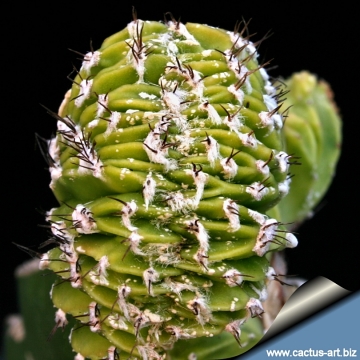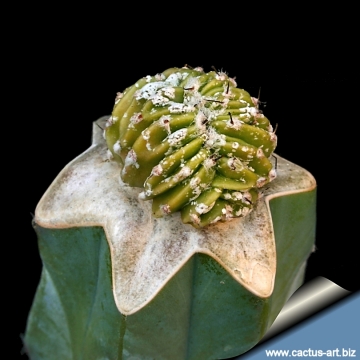Accepted Scientific Name: Astrophytum ornatum (DC.) F.A.C.Weber in Bois
Dict. Hort. [Bois] 1: 467. 1896 Bois

Astrophytum ornatum f. cristatum Photo by: Valentino Vallicelli
Origin and Habitat: Garden origin (Nursery produced cultivar)
Synonyms:
See all synonyms of Astrophytum ornatum
back
Accepted name in llifle Database:Astrophytum ornatum (DC.) F.A.C.Weber in BoisDict. Hort. [Bois] 1: 467. 1896Synonymy: 23
Cultivars
(4):
back
Description: Astrophytum ornatumSN|12948]]SN|3660]] is a shortly columnar cactus appearing star-shaped from above, with white cross bands of woolly scales. It is the largest and easiest to grow and also the fastest of the astrophytums. The crested form Astrophytum ornatum f. cristatumSN|3660]]SN|12948]] is still very rare and sought after by collectors, for its unique features. There are several crested forms mainly selected by Asian growers.
Stem: Fan shaped, depressed centrally along the lime meristem, greyish-green to dark-green with more or less dense white or yellow woolly flakes in bands forming an ornate pattern.
Ribs: Straight, rather prominent, strongly compressed, more or less sinuate and crenate.
Areoles: 1 to 5 cm apart, at first yellowish-white felted, later grabrescent.
Radial spines: 5-11 stout, 2-4 cm long usually straight, subulated or ± laterally compressed, amber yellow, later brown and finally grey.
Central spine: Usually 1 rather larger.
Flowers: At apex, large, lemon-yellow 7-12 cm broad, inner perianth segments broadly oblong, with a broad, more or less serrated apex, tube short woolly, scale on ovary, dark and very narrow.
Subspecies, varieties, forms and cultivars of plants belonging to the Astrophytum ornatum group
Bibliography: Major references and further lectures
1) James Cullen, Sabina G. Knees, H. Suzanne Cubey “The European Garden Flora Flowering Plants: A Manual for the Identification of Plants Cultivated in Europe, Both Out-of-Doors and Under Glass” Cambridge University Press, 11/Aug./2011
2) David Hunt, Nigel Taylor “The New Cactus Lexicon” DH Books, 2006
3) Edward F. Anderson “The Cactus Family” Timber Press, 2001
 Astrophytum ornatum f. cristatum Photo by: Cactus Art
Astrophytum ornatum f. cristatum Photo by: Cactus Art Astrophytum ornatum f. cristatum Photo by: Cactus Art
Astrophytum ornatum f. cristatum Photo by: Cactus ArtCultivation and Propagation: It is a popular summer-growing species of relatively easy cultivation.
Growth rate: Slow-growing. It needs to be at least 15 cm tall to bloom . This might take 7 to 12 (or more) years depending on the length of the growing period in the local climatic conditions.
Soil: Grow it in an open standard, sandy-gritty cactus compost and provide a very good drainage.
Exposure: It is suited for sunny-brightly exposure, but can tolerate light shade. However it will do its best with lots of sun and become stressed with inadequate light which could result in poor growth and unnatural shape. It has a good heat tolerance.
Watering: Water regularly (about once a week) during the growing season and keep it completely dry during winter or when night temperatures remain below 10° C. Water it less than average if in bigger pots.
Fertilization: Feed them once during the growing season with a fertilizer specifically formulated for cactus and succulents (high potash fertilizer with a dilute low nitrogen), including all micro nutrients and trace elements diluted to ½ the strength recommended on the label. They thrive in poor soils and need a limited supplies of fertilizer to avoid the plants developing excess vegetation, which is easily attacked by fungal diseases.
Special need: It is suited for airy exposures. Provide very good ventilation. Nearly all problems occur as a result of overwatering and poor ventilation, especially when weather conditions are dull and cool or very humid. ere.
Hardiness: It likes warmth (recommended minimum winter temperature 5° C) But plants kept perfectly dry can easily survive to light frost (it is reported hardy to -12 ° for brief periods).
Pests & diseases: These cacti may be attractive to a variety of insects, but plants in good condition should be nearly pest-free, particularly if they are grown in a mineral potting-mix, with good exposure and ventilation. Nonetheless, there are several pests to watch for:
- Red spiders: Red spiders may be effectively rubbed up by misting the plants from above.
- Mealy bugs: Mealy bugs occasionally develop aerial into the new leaves and flowers with disfiguring results, but the worst types develop underground on the roots and are invisible except by their effects.
- Scales, thrips and aphids: These insects are rarely a problem.
- Rot: Rot is only a minor problem if the plants are watered and “aired” correctly. If they are not, fungicides won't help all that much.
Propagation: It can be propagated vegetatively by graft or cuttings.












